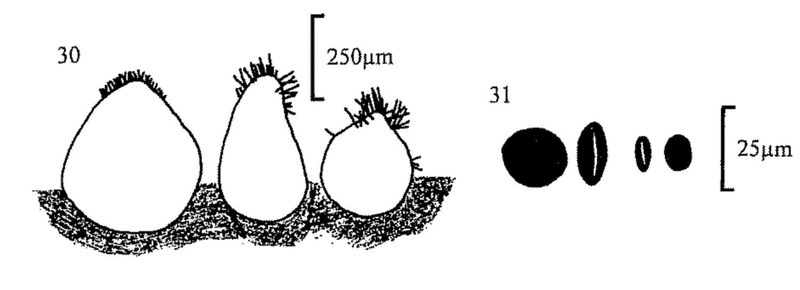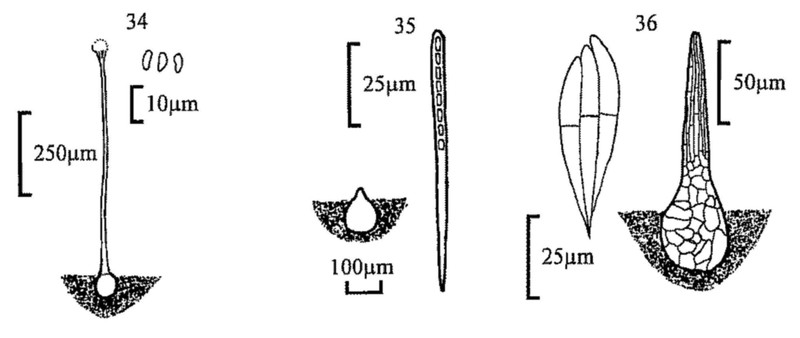|
114(3)
|
Spores 20-28 × 12-16µm, with subacute ends, each with a germ pore.
|
|
Gelasinospora adjuncta
|
|
-
|
Spores larger.
|
115
|
|
115(114)
|
Asci 4-spored. Spores 24-29 × 15-18µm, with rounded ends and one germ pore.
|
|
Gelasinospora tetrasperma
|
|
-
|
|
Asci 8-spored. Spores 26-35 × 22-27µm
|
Gelasinospora cerealis
|
|
|
116(4)
|
Perithecia orange to golden, often gregarious, almost spherical, necks ca 50µm diam., 15µm high, setae at ostiole hyaline, up to 35 × 3µm. Spores limoniform, with a germ pore at
each end, 15-25 × 9-16µm.
|
|
Sphaerodes fimicola (fig. 33)
|
|
-
|
Perithecia yellow or reddish brown (darker when filled with mature spores), neck 50µm long, with setae at the ostiole 40-70µm long. Spores dark brown to black, limoniform, 20-34 ×
11-17µm, with apical germ pore.
|
|
Melanospora brevirostris
|
|
117(2)
|
|
Asci more than 8-spored.
|
see Key 1 at 86
|
|
|
-
|
Asci with 8 or fewer spores, or asci evanescent, not readily observed.
|
118
|
|
118(117)
|
Perithecia orange/yellow, 500-1000µm diam. Spores long (over 45µm) or 2-celled if shorter.
|
119
|
|
-
|
Perithecia smaller, or black or with a neck. Spores shorter (less than 20µm) or septate if longer.
|
120
|
|
119(118)
|
Perithecia orange, 500-1000µm diam., in small groups on a limited stroma. Spores thick walled, 48-60 × 22-26µm, with a gelatinous sheath.
|
|
Selinia pulchra
|
|
-
|
Perithecia orange yellow, superficial, ca 500µm diam., with ostiole in a disc surrounded by silvery triangular tufts of hyphae ca 100µm long. Spores ellipsoid, 1-septate,
12-14 × 4-5µm.
|
|
Nectria suffulta
|
|
120(118)
|
Perithecia reddish brown or pale, hyaline, with a distinct neck.
|
121
|
|
-
|
Perithecia black.
|
131
|



